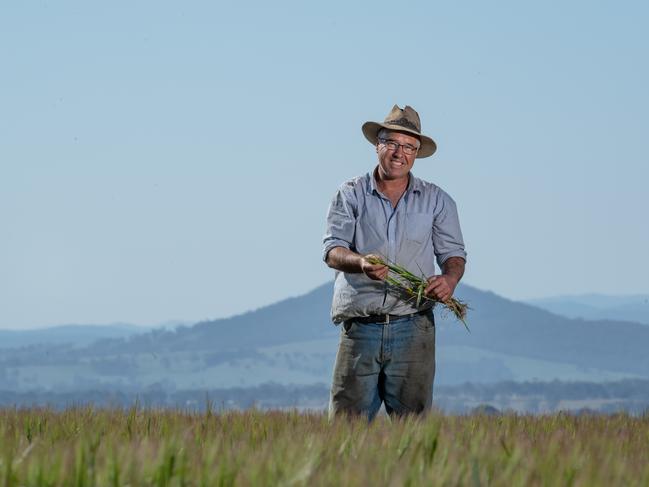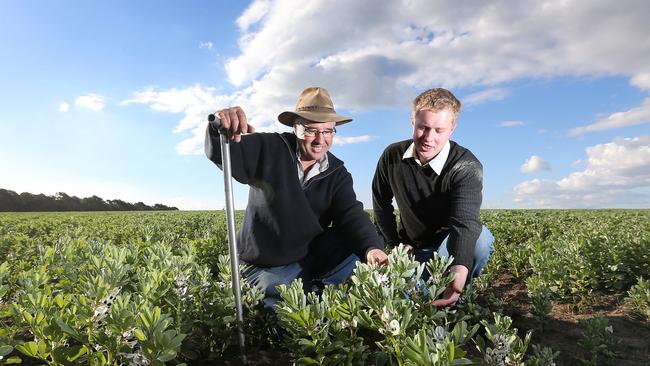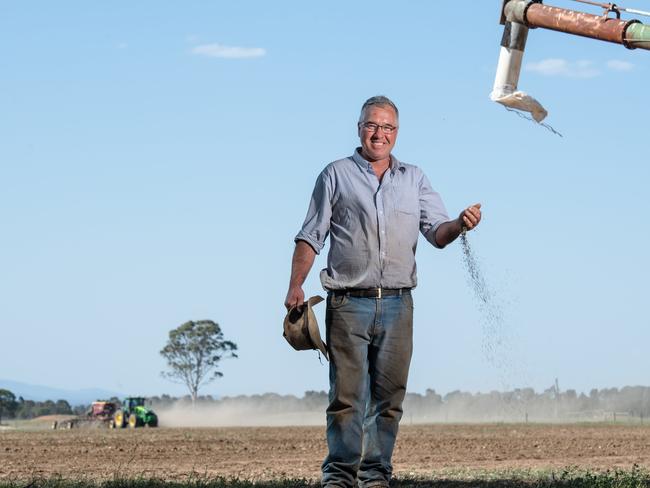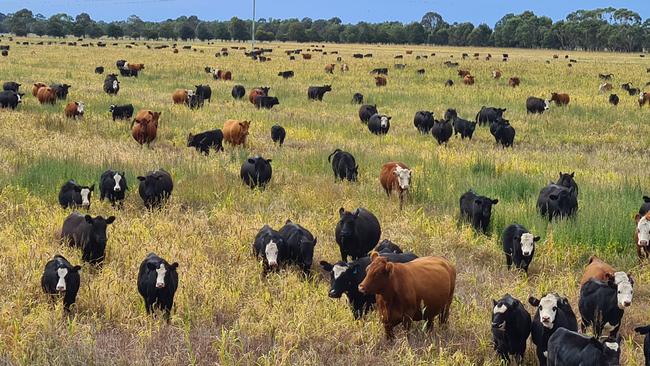Balanced soils boost profits for Caithness family at Bairnsdale
Creating the perfect soil balance has helped the Caithness family to boost fertility levels, stocking rates and their bottom line.

Trevor Caithness is convinced that the profitability of any farm starts with the soil.
Having bought and renovated nine properties totalling 1800 hectares in East Gippsland in the past 20 years, been actively involved with local farm research trials, and undertaken a Nuffield Scholarship on alternative sources of nutrients for pasture and cropping, Trevor has a fair basis to draw the conclusion.
“Get the soil in good shape and then whatever you grow on top – whether it’s pasture, crop or livestock – will perform very well and then profit just naturally comes,” he said.
Trevor and wife Carryn run a mixed cropping and livestock enterprise at Bairnsdale with their three children, Toby, Teagan and Telina, and their respective partners.
The operation has transitioned in the past 10 years from a 50:50 split to 30 per cent cropping and 70 per cent livestock as perennial pasture improvement works have enabled them to increase breeding numbers.
They run 850 Angus, Hereford and crossbred cows to produce 700 calves a year for the Coles Graze grass-fed beef label.
Trevor has developed a semi-trailer that he uses to deliver consignments of 28 steers and heifers to the JBS Swifts abattoir at Brooklyn in Melbourne each fortnight, and return home with a backload of bulk commodity – predominantly poultry manure – that is the basis of their fertiliser program.

BALANCING MICROBES
The Caithnesses have used cropping as a development tool on all of their properties that have had poor pasture bases and low fertility.
By introducing a cropping program for the first three to five years, it allowed them to improve drainage and nutrient levels to a point where they could also increase stocking rates.
Poultry litter is used as a cost effective base fertiliser while sufficient lime and gypsum is added where necessary to correct pH issues. If lacking, trace elements such as copper, zinc sulphate, manganese and boron are also used to create balance.
“We farm by the principles of an Albrecht balanced soil system so 65 per cent calcium, 12 per cent magnesium and 5 per cent potash within our soil cation,” Trevor said.
“It is where a lot of the stock health comes from and hence the performance of the livestock.”
Trevor said while chook manure provided key nutrient values in NPK it also brought with it biology.
“It does actually inoculate your soil with a certain amount of microbes and life, which are beneficial,” Trevor said.
“As we’ve done the different soil improvement works, we are also getting a general increase in soil carbon, which is an important and interesting space as we go into this next phase of farming.”
Their soils predominantly consist of sandy loam over clay, which can get waterlogged quickly but also lose moisture rapidly.
Through deep ripping, deliberately lifting some of the clay through cultivation to mix with the sandy loam and adding appropriate amounts of lime and gypsum, they have also been able to increase the water- and nutrient-holding capacity of the soil.

DRAINS FOR GRAINS
The annual cropping program includes 1000 tonnes of wheat and barley, 500 tonnes of canola and 200 tonnes of faba beans.
The Caithness’ aim for four to five tonne a hectare for wheat and barley and 2.5t/ha for canola.
“The wet weather has been fairly disastrous on the cereals in recent years and we’ve had a huge issue with trying to keep fungal diseases out,” Trevor said.
Two years ago they introduced altitude mapping system T3RRA to create strategically placed drains in crop paddocks.
Results were immediate and positive with canola yields increasing by 800kg/ha.
Canola is sent to Melbourne for crushing, while the faba beans are bought by local sheep farmers.
“We have developed about 3000 tonnes of grain storage on our properties because I believe you need to sell products when you are ready to sell them, not when they are coming off the paddocks,” Trevor said.
“The other issue, our nearest grain receival is 320km away at Geelong.”
All their wheat and barley is sold to a nearby dairy farmer – a mutually beneficial relationship that cuts out third party involvement.
“We work on a fixed price arrangement so they know what their grain will cost for the coming year and we know what our return will be for that grain,” Trevor said.
FLOUNDER TO FLOURISH
Prior to supplying branded beef to Coles eight years ago, Trevor and Carryn “floundered” between supplying steers to feedlots and selling direct to abattoirs.
Their current production system means kill spaces are booked in advance and the Caithnesses can focus on producing the right animal specifications for that committed date and market.
“I think it takes the stress out of the business because you have a plan and you have the ability to change your production systems to match that plan,” Trevor said.
“It is quite clear what the objective is and that is to have X number of cattle ready on a certain date.
“If you do need to go and buy some additional feed in, you know what you are spending and you have a very good idea of what your return is going to be. It is taking risk out of the business.”
Trevor, who is the current volunteer CEO of Gippsland Ag Group, described seasonal conditions in East Gippsland as “reliably unreliable” and said reducing the risk associated with those fluctuations was integral to their business.
“Part of our farming principle is to be very content to have large fodder reserves,” he said.
“At the moment we would have 2500 tonnes of pit silage buried in the ground and in excess of 800 tonnes of hay.
“It is a mindset that you need to develop where you are content to actually work quite hard and spend quite a bit of money to put reserves away when you have an abundant season then sleep easier when you find the seasons are failing you.”
Despite the current “disastrous” season with some of the lowest June and July rainfall figures on record, the Caithnesses are able to run their program as normal.

FINISHING TOUCHES
The cattle herd is rotationally grazed except during calving when set stocking is undertaken for eight weeks for ease of management.
Between 150 and 200 heifers are retained each year as herd replacements and joined as part of a fixed term AI program. They calve at 22 months – two months before the main herd.
“That is a strategy we feel is guaranteed a very successful second joining of that heifer because she has a little bit more of a holiday from the time she calves before the time she needs to be cycling,” Trevor said.
Composite bulls are used for their hybrid vigour across 80 per cent of the herd while the remainder is serviced by Angus-cross bulls. Calving percentages are 94 per cent for heifers and cows.
Calves are generally weaned on to good quality silage from 10 months but if seasonal conditions are tight, it is conducted from five to six months of age.
Calves are finished on perennial pastures of lucerne, rye-grass, clover and cocksfoot. Supplementary grain free pellets are used if necessary and calves are turned off at 14 months and 500kg live weight or 270kg carcass weight.
PROFIT OVER SCALE
The Caithnesses have spent time refining their management system and working on synergies between commodities to ensure they are complementary.
Summer crops of brassicas mixed with millet are planted to help weaner calves transition and relay cropping is conducted with barley.
“In the middle of October we use an aeroplane to fly rape seed, clover and millet over the top of the barley crop and that seed will germinate in the floor of that existing standing barley crop,” Trevor said.
“Once we have harvested the barley at Christmas time, we’ve got green fodder growing in the bottom of the barley stubble. It turns into very good quality feed for our weaners because you’ve got a nice piece of fibre in the barley stubble and green crop growing up underneath it.
“That is a very cheap way of producing summer feed that we have developed over the years.”
Trevor and Carryn aim to stabilise herd numbers once they reach 1000 breeders.
“You don’t need to be the biggest, you need a good profitable business in good shape for future generations,” Trevor said.
“Working with Coles is like working with another family business. I’m not trying to pump their tyres up. I have found them amazing to work with. There is a huge degree of respect for their suppliers and a degree of transparency which makes doing business of our nature very easy.”




